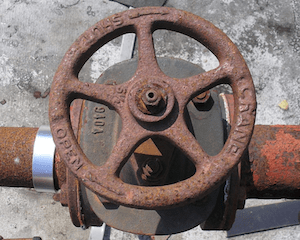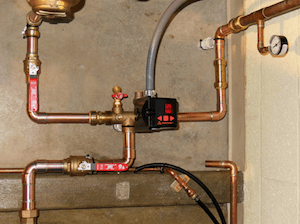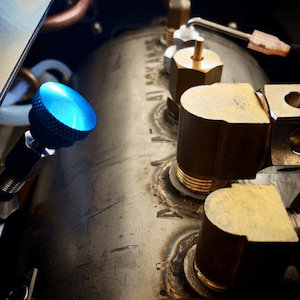What is the Best Type of Flow Control Valve for Your Application? Learn about Gate Valves, Globe Valves and Other Flow Control Valves


There are countless types of valves for use across a variety of industries and applications. When it comes to flow control valves, valve types range from simple to sophisticated; some valves are complex enough to adjust automatically to pressure and temperature variations. No matter their construction, flow control valves are designed to regulate the flow or pressure of fluids, and they typically react to signals generated by flow meters or temperature gauges.
Flow control valves can serve a number of different functions within a hydraulic flow system depending on the specific type that is used. One of the most common uses of a flow control valve is to regulate the speed of motors or cylinders within the system. This function is possible due to the capability of a flow control valve to affect the rate of energy transfer at any given point in a system by impacting the flow rate.
The ability to reduce or increase pressure in a system has a number of benefits. System operators can use a flow control valve to rapidly depressurize a serviceable hose and change fittings quickly. They are also used in many consumer applications such as showers, faucets, and lawn watering systems to easily reduce the amount of water consumed without impacting the overall system performance. Flow control valves are also known for their reliability and typically have a long operating lifetime as they are not prone to clogging due to their design.
Due to these flexible performance parameters, flow control valves have found wide use in applications across materials handling, food processing, and automated factory and warehouse equipment.
The most common valve types in flow control industries include:
Continue reading to learn more about each of these types of flow control valves and their functions.

Gate valves are general service valves primarily used for on/off, non-throttling service. Specifically, gate valves are used in applications requiring a straight-line flow of fluid with minimum  restriction is desired. Gate valves operate when the user rotates the stem in a clockwise to close (CTC) motion or a clockwise to open (CTO) motion. The gate moves up or down on the threaded step when an operator moves the stem, which is why it is a multi-turn valve; the valve must turn several times for it to go from open to closed, and it is the slow operation that prevents water hammer effects. Engineers also utilize gate valves when minimum pressure loss and a free bore are required. Typical gate valves have no obstruction in the flow path, which results in a minimal loss of pressure.
restriction is desired. Gate valves operate when the user rotates the stem in a clockwise to close (CTC) motion or a clockwise to open (CTO) motion. The gate moves up or down on the threaded step when an operator moves the stem, which is why it is a multi-turn valve; the valve must turn several times for it to go from open to closed, and it is the slow operation that prevents water hammer effects. Engineers also utilize gate valves when minimum pressure loss and a free bore are required. Typical gate valves have no obstruction in the flow path, which results in a minimal loss of pressure.
Gate valves may be used for several fluids. Generally, gate valves are applicable for potable water, wastewater, and neutral liquids; in temperatures between -20 and 70 degrees Celsius; maximum 5 meter/second flow velocity; and up to 16 bar differential pressure. Gate valves also are applicable for gases with temperatures between -20 and 60 degrees Celsius; maximum 20 meter/second flow velocity; and up to 16 bar differential pressure.
There are two types of gate valves: parallel and wedge-shaped. Parallel gate valves feature a flat gate between two parallel seats. Wedge-shaped gate valves are comprised of two inclined seats and an inclined gate that is just a bit mismatched.
Image via Flickr by Elsie esq
A linear motion valve, globe valves stop, start, and regulate flow. Globe valves initiate closure via a plug featuring a flat or convex bottom that is lowered onto a horizontal seat situated in the center of the valve. When a user opens the valve, the plug raises to allow fluid to flow. Globe valves are used for on/off and throttling applications because the disk of the valve can be removed from the flow path completely or it can completely close the flow path. While this type of flow control valve does produce slightly higher pressure drops than straight-through valves like gate, plug, and ball valves, they are applicable in situations where the pressure drop through the valve is not a controlling factor.
The practical size limit for globe valves is NPS 12 (DN 300) because the entire system pressure exerted on the disc transfers to the valve stem. It is possible, however, to have globe valves larger than NPS 12 (DN 300), and manufacturers and engineers have created and used globe valves up to NPS 48 (DN 1200).
A cost-effective flow control valve, pinch valves are ideal for applications of slurries or liquids containing significant amounts of suspended solids. Pinch valves seal using one or more flexible elements like rubber tubes that become pinched to turn off the flow. These rubber sleeves are the valve’s only wetted part, and their flexibility allows pinch valves to close tightly around entrapped solids. Air or hydraulic pressure is placed directly on the elastomer sleeve to actuate pinch valves. A pinch valve’s body acts as a built-in actuator, which eliminates expensive hydraulic, pneumatic, or electric operators and results in the cost-effectiveness of this type of flow control valve.
 Diaphragm valves are characterized by a flexible disc that contacts a seat at the top of the valve body and forms a seal. The diaphragm is flexible and pressure-responsive; it transmits force to open, close, or control a valve. While diaphragm valves are related to pinch valves, they use an elastomeric diaphragm rather than an elastomeric liner in the valve body. The elastomeric diaphragm is attached to a compressor and separates the flow stream from the closure element. Diaphragm valves are ideal for handling corrosive, erosive, and dirty services.
Diaphragm valves are characterized by a flexible disc that contacts a seat at the top of the valve body and forms a seal. The diaphragm is flexible and pressure-responsive; it transmits force to open, close, or control a valve. While diaphragm valves are related to pinch valves, they use an elastomeric diaphragm rather than an elastomeric liner in the valve body. The elastomeric diaphragm is attached to a compressor and separates the flow stream from the closure element. Diaphragm valves are ideal for handling corrosive, erosive, and dirty services.
There are many advantages to using diaphragm valves: they are extremely clean, feature a leak-proof seal, have a tight shut-off, are easy to maintain, and reduce leakage to the environment. Diaphragm valves also may be repaired without interrupting a pipeline. On the other hand, the disadvantages of using diaphragm valves include only being able to use them in moderate temperatures of -60 to 450 degrees Fahrenheit and in moderate pressures of approximately 300psi. Diaphragm valves cannot be used in multi-turn operations and do not have industry standard face-to-face dimensions. Also, the body of a diaphragm valve must be made of corrosive-resistant materials.
Image via Flickr by William Herron
Needle valves are volume control valves that restrict flow in small lines. Fluid moving through the valve turns 90 degrees and flows through an orifice that serves as the seat for a cone-shape-tipped rod. The orifice size changes when the user positions the cone in relation to the seat. Needle valves are similar to globe valves in that they share a few design features and have similar benefits; for example, both needle valves and globe valves empower operators to change flow rate using a threaded rotating stem. The difference between needle valves and globe valves is the precision that needle valves can achieve. In fact, needle valves are an ideal choice for calibration applications because they are capable of being fine-tuned.
 Needle valves can provide positive shutoff in order to allow gauges and other measurement instruments to be installed or removed safely. That’s also why needle valves may be used in a range of industries, from petrochemicals to biofuels. It is the needle valve’s finely-threaded valve stem that gives it a significant mechanical advantage by allowing operators to seal it using only minimal force. One disadvantage of needle valves, however, is that the visual inspection alone is not enough to determine whether a needle valve is open or closed.
Needle valves can provide positive shutoff in order to allow gauges and other measurement instruments to be installed or removed safely. That’s also why needle valves may be used in a range of industries, from petrochemicals to biofuels. It is the needle valve’s finely-threaded valve stem that gives it a significant mechanical advantage by allowing operators to seal it using only minimal force. One disadvantage of needle valves, however, is that the visual inspection alone is not enough to determine whether a needle valve is open or closed.
Flow control valves are necessary components in a broad range of industries. Determining which flow control valve type is best for your particular situation depends on a host of criteria, but the most commonly used types include gate valves, globe valves, pinch valves, diaphragm valves, and needle valves.
Image via Flickr by nalundgaard
While the five types of flow control valves described above are some of the most commonly used valve types, there are other types of flow control valves with features that make them suitable for different applications. Here’s a look at a few other types of flow control valves.
Butterfly valve. A butterfly valve is operated by rotating a disk within the flow area and, due to this design, it does not have linear flow characteristics. This makes these valves less precise than the more common flow control valve types above. For this reason, it can often be dismissed as a flow control valve choice even though it is useful in some applications that do not require a very high degree of accuracy. They are also a very affordable valve option, which makes it worthwhile to consider them in the right applications.
Plug valve. Plug valves come in a variety of configurations and are operated by rotating a cylindrical or cone-shaped plug within the valve body to regulate the flow through a hollow area of the plug. For flow control applications the most common design is an eccentric plug valve, which uses a half plug to create a higher seating force with minimal friction as it is opened and closed. This has the advantage of greater shut off capability which is ideal for flow control situations.
Ball valve. Ball valves are commonly used in flow systems across numerous industries due to their low cost, durability, and excellent shutoff capability. Similar to butterfly valves, they are not as effective for flow control applications that require a high degree of accuracy and control. One of the reasons for this is that a ball valve requires a high degree of torque to open and close that prevents an operator from making fine adjustments. There is also a certain amount of “play” between the stem and the ball which can make finding specific flow rates difficult. For flow control applications where a ball valve is possible, such as filling a tank to a reasonable degree of accuracy, a trunnion or v-port ball valve design is usually the best choice.
Flow control valves are used in a variety of applications, such as plumbing, mechanical, and gas dispensing applications. There are many factors to consider when choosing the appropriate flow control valve for an application, such as the characteristics of the fluid, service conditions, how frequently the valve is operated, and maintenance and environmental considerations. With a variety of valve types available, comparing the function and performance of various valves alongside your application specifications will help you identify the most suitable flow control valve for your application.
Our sales engineers are experts in automatic asset tracking, tagging and identification,a nd can answer all your questions. Get in touch now.
Lets Talk ›